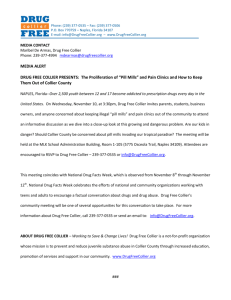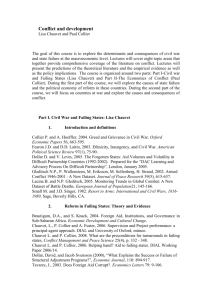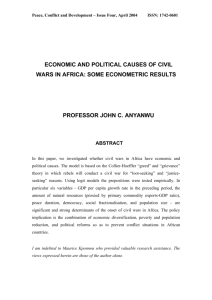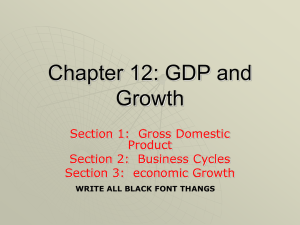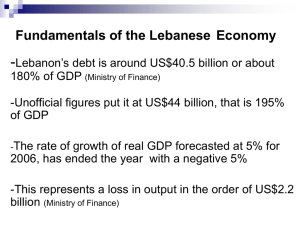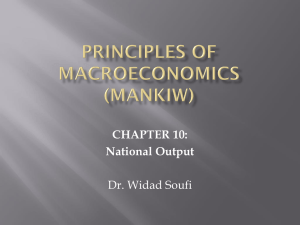5.+The+Merits+of+Methodology_Slides
advertisement
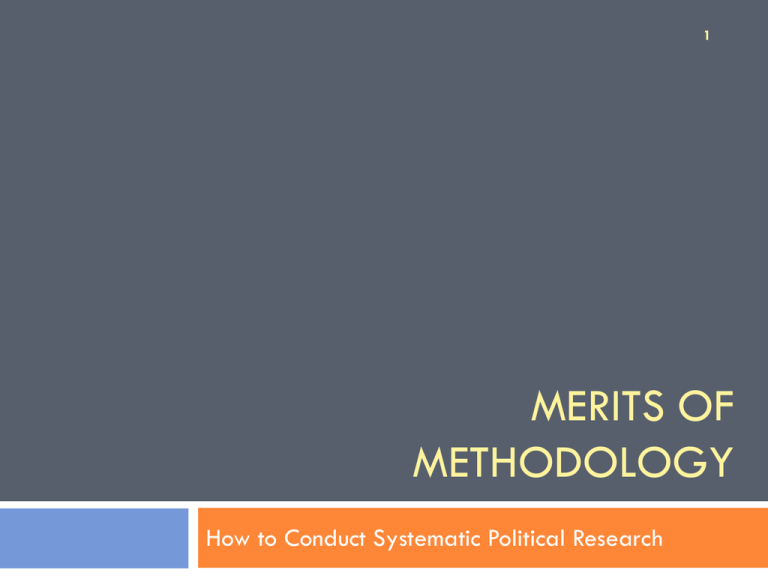
1 MERITS OF METHODOLOGY How to Conduct Systematic Political Research Lecture Structure 2 Aims Methods of Comparison Single Case Study Using Quantitative Literature Applying a Theory vs. Discursive Method 3 Methods of Comparison Methodology 4 Definition: A body of methods, rules, and postulates employed by a discipline: a particular procedure or set of procedures. The analysis of the principles of inquiry in a particular field. (Merriam-Webster Dictionary) Questions addressed in this course 5 How should we study conflict? What causes conflict? Who participates in conflict? How do people behave during conflict? What are the consequences of conflict? How do we evaluate conflict? Comparing Literature 6 What is the key similarity between Mamdani (2001) and Collier & Hoeffler (2004)? Comparing Literature 7 Mamdani (2001) Rwandan genocide 1994 Qualitative evidence Collier and Hoeffler (2004) Civil conflicts 1960-1999 Quantitative evidence Methods of Comparison 8 Three basic approaches to answering a research question: Large-N: > 50 cases. Small-N: 2-20 cases. Single case study: 1 case. N = number of cases/observations. Small-n (aka ‘comparative method’) 9 Cases are intentionally selected in order to establish ‘control.’ Most Similar Systems Design (MSSD). Similar cases. Different outcome. Most Different Systems Design (MDSD). Different cases. Same outcome. Most Similar Systems Design (MSSD) 10 Which cases would you use to investigate the link between ethnic tensions and civil war, using this research design? Most Different Systems Design (MDSD) 11 Which cases would you use to investigate the link between ethnic tensions and civil war, using this research design? 12 Single Case Study What is a Single-Country Study? 13 “any study in which a single country forms the basic unit of analysis, but which may also be broken down into smaller units across time and space...” (Landman, 2000: 86) N=1 What is a Case Study? 14 Single observation/case: Time Space Level N=1 of Analysis Functions of a Case Study 15 Classification. Contextual description. Hypothesis generation. Theory testing: Most likely study. Least likely study. Outliers. Process tracing. Limitations of Single Case Studies 16 Limited scope/generalisability. Selection bias. Further Reading 17 Landman, Todd. 2007. Issues and Methods in Comparative Politics: An Introduction. London: Routledge. 18 Quantitative Literature Regression Analysis (1/2) 19 4.5 4 3.5 Conflict 3 2.5 2 1.5 1 0.5 0 0 0.5 1 1.5 2 2.5 Natural Resources/GDP 3 3.5 Characteristics of Quantitative Literature 20 Large-N Empirical data Statistical techniques Large-n 21 How many observations are examined in Collier and Hoeffler (2004)? Collier & Hoeffler’s dataset by the numbers 22 98 countries 79 civil conflicts 1960-1999 divided into 5-year periods 750 observations Concepts in this Course 23 Authority and coercion; Structural violence and deadly force; Conflict and war; Positive and negative peace; Peacemaking; Peacekeeping; Peace enforcement; Peacebuilding; The military; and Militarism. Concept v. Variable 24 Concept = abstract. Variable = observable/measurable. How do we measure the following concepts? 25 Conflict Democracy Ethnic tension Inequality Statistical Techniques 26 Used to look for patterns between variables. Correlation: relationship between two variables. Correlation is not the same as causation! Example: ice cream and summer. Natural Resources and Conflict 27 8 7 Conflict 6 5 4 3 2 1 0 0 1 2 3 4 Natural Resources/GDP 5 6 7 Regression 28 Adds a line of best fit to the observed result. Regression analysis therefore measures the extent to which independent variables predict the dependent variable. Regression Analysis (1/2) 29 4.5 4 3.5 Conflict 3 2.5 2 1.5 1 0.5 0 0 0.5 1 1.5 2 2.5 Natural Resources/GDP 3 3.5 Regression Analysis (2/2) 30 8 7 Conflict 6 5 4 3 2 1 0 0 1 2 3 4 Natural Resources/GDP 5 6 7 Terminology 31 Significance Levels Regressor/Predictor/Independent Variable P-values Confidence intervals Limitations 32 Cannot prove causation. Limited interpretive ability (i.e. explaining why these relationships exist). Use of proxies. Analysing Collier & Hoeffler (2004) 33 Q: Does natural resource prevalence explain the onset of civil conflict? Steps to follow: How did they operationalise and measure these concepts. Do these proxies make sense? Is there correlation? In other words – what do we see happening to the likelihood of conflict variable when we look at different natural resource/GDP values. Ask how much we should read into the correlation. Ask the students here what might make us more or less likely to find one of the correlations important or suggestive of a causal relationship. 34 Theory and Your Research Applying Theory Systematically 35 Logic of theory Language that a theory demands Units of analysis Consistency through the paper Acknowledging limitations Referring to Theory as Evidence 36 Not constrained by the logic of the theory Used to add to understanding, or to hold theory up to criticism or praise Can compare explanations offered by different theories
